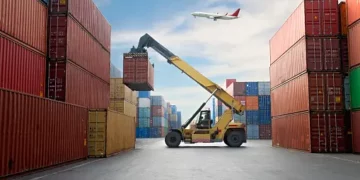In a world moving towards stability, businesses globally are examining a new landscape, drawing lessons from the pandemic. Over the past two years, the global supply chain experienced unprecedented disruptions that reshaped the way we shop, manufacture goods, work, and drive economic activities.
Significant shifts have occurred in the logistics and supply chain sector in recent decades. Technological advancements, the rise of e-commerce, globalization, sustainability concerns, and heightened competition have collectively contributed to reshaping the industry.
Key factors responsible for these changes include the use of technologies like GPS, RFID, Artificial Intelligence, and the Internet of Things (IoT). These technologies enable real-time monitoring and operational improvements. E-commerce growth has necessitated faster and more flexible delivery methods, with a specific focus on the last mile.
Globalization has led to the development of more complex logistics systems to manage cross-border shipments, and a growing emphasis on sustainability has driven companies to adopt environmentally friendly and socially responsible supply chain practices.
For the logistics industry, adaptation and innovation are essential for staying ahead of the curve. E-commerce has gained significant importance, especially in the wake of the “new normal.” To survive, adapting to a dramatically altered supply chain is crucial, as these supply chains remain vulnerable to disruption. Studies show that, on average, companies experience disruptions lasting one to two months once every 3.7 years. To mitigate the losses associated with such disruptions, companies are building flexibility into their supply chains and investing in new technologies to respond quickly to challenges.
Over the last two decades, the Indian logistics and supply chain sector has evolved from being a support sector to becoming a high-impact sector. In 2020, the size of the Indian logistics industry was approximately $100 billion, a significant increase from $40 billion in 2010 and $15 billion in 2000. Projections estimate that the Indian logistics market will grow to about $380 billion by 2025.
The landscape of logistics and supply chain management has seen dramatic changes over the past decade. Advancements in warehouse management systems (WMS), the adoption of Robotic Process Automation (RPA), and the use of Artificial Intelligence (AI), Machine Learning (ML), and IoT for inventory management and order placement have transformed business operations. Gartner predicts that by 2026, over 75% of commercial supply chain management application vendors will offer embedded advanced analytics, AI, and data science capabilities. Supply chain application vendors are using AI and Augmented Reality (AR) to make faster and more accurate decisions.
Furthermore, the rise of e-commerce and online grocery shopping, with contactless deliveries and cashless payments, has redefined consumer-facing business. Retailers are under immense pressure to offer a seamless and personalized customer experience, going beyond traditional retail models. The use of drones has allowed retailers to offer lightweight goods delivery, reducing fulfillment costs and capital expenditures associated with physical stores.
Another significant change is the rapid proliferation of third-party logistics (3PL) and fourth-party logistics (4PL) providers, especially as the manufacturing sector expands. The Indian 3PL market is expected to grow at a rate of over 11.5% from 2020 to 2025. Outsourcing supply chain management has been a trend set by the manufacturing sector, but it has also extended to other industries. Service providers have become key partners, offering comprehensive end-to-end solutions that cover documentation, tracking, warehousing, and legal compliance.
Many logistics players are also embracing eco-friendly and sustainable operations. These operations are smarter, technology-driven, and cost-effective, offering benefits like reduced emissions, lower fuel and maintenance costs, and increased productivity. This shift includes using electric vehicles and building energy-efficient warehouses.
Sectors such as automobiles, e-commerce retail, farming and agriculture, and healthcare are driving demand for multi-modal logistics. With over 70% of the world’s population residing in urban areas, the need for local delivery options, such as same-day delivery, has grown to reduce transportation costs and enhance efficiency. India’s Prime Minister Narendra Modi announced an investment of Rs 100 lakh crore in the Gati Shakti Master Plan, aiming to provide multimodal connectivity to over 1,200 industrial clusters, reducing logistics costs and improving connectivity.
Lastly, the Indian container manufacturing industry has experienced remarkable growth over the last two decades. India’s container market ranks among the strongest globally, with production levels doubling every 6-8 years. India boasts a significant manufacturing base and a growing export economy. This growth coincides with India’s status as one of the fastest-growing container manufacturing countries worldwide.
The transportation and logistics industry is undergoing massive changes, bringing both risks and opportunities. New technology, market entrants, customer expectations, and business models have reshaped the industry. By embracing these changes, supply chain and logistics operations have become more efficient, agile, and sustainable over the last two decades.
Discover comprehensive supply chain report news insights at The Supply Chain Report. For international trade resources, visit ADAMftd.com.
#GlobalSupplyChain #SupplyChainInnovation #LogisticsIndustry #EcommerceGrowth #TechnologyInLogistics #GPS #RFID #ArtificialIntelligence #IoT #SustainabilityInSupplyChain #LastMileDelivery #GlobalLogistics #RoboticProcessAutomation #MachineLearning #WarehouseManagement #LogisticsTransformation #ThirdPartyLogistics #FourthPartyLogistics #SustainableLogistics #ElectricVehicles #MultimodalLogistics #IndianLogistics #ContainerManufacturing #GatiShaktiMasterPlan #AIinSupplyChain #FutureOfLogistics #EcoFriendlySupplyChain #BusinessAdaptation #SupplyChainResilience #AdvancedAnalytics #LogisticsTechnology #EcommerceLogistics

















